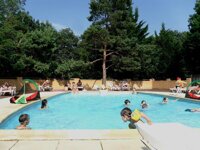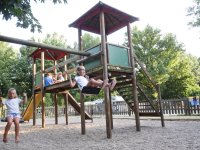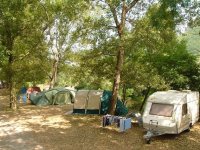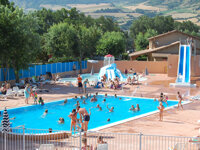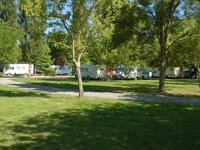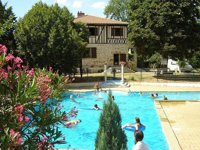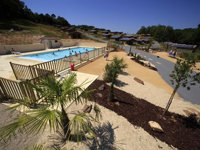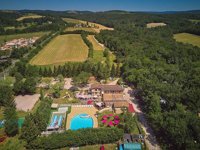
Most Beautiful Villages in Midi-Pyrénées
The Midi-Pyrénées is a former administrative region which comprises the Midi-Pyrénées, at the centre of which is Toulouse, and the Pyrénées Orientales, which belongs to the southern Languedoc and borders Andorra and Spain. Located in a stunning area of France, with pretty towns and swathes of sunflower fields and vineyards, which steadily rise to become the mountainous landscape of the Pyrenees themselves. This region is now part of the new region Occitania.
Points of interest: Albi Cathedral | Lourdes | Rocamadour | Millau Viaduct | Padirac Cave | Church of the Jacobins, Toulouse | Canal du Midi | Gorges du Tarn
Sorry, this map cannot be displayed.
The following consent is required:
Tracking & performance, Targeting & advertising.
Ariège

Camon
An explosion of roses in the late spring, “the village of 100 rosebushes” or Camon is nestled in a flex of the Hers river. Rose bushes were once planted as a sign of good health by winegrowers and the village celebrates this with the annual rose festival. The village is also known as “Little Carcassonne” because of its fortifications and central Benedictine abbey.
Aveyron

Belcastel
At the start of the 20th century Belcastel was in ruin. Access to the village was difficult and many of its buildings including the château had fallen into disrepair. It wasn’t until 1974 that famous French architect Fernand Pouillon bought the château and proceeded to restore it by hand over the course of 8 years and with the help of many locals the village was also renovated to its former glory. Nowadays its cobbled streets and medieval bridge spanning the Aveyron river make it a mustvisit. Watercolour competitions and art exhibitions are held in the village each summer.

Brousse-le-Château
Resting at the confluence of the Tarn and Alrance, Brousse-le-Château is small but packed full of history. Its old Gothic bridge spanning the River Alrance, cobblestone streets, neat stone houses adorned with flowers, 15th century fortified church and hilltop castle ruins are just a handful of the sights on offer in the village. The local market takes place every Tuesday morning in July and August.

Conques
The small, largely depopulated village of Conques occupies a spectacular position on the flanks of the steep, wooded gorge of the Dourdou. The village was established alongside the founding of the abbey in about 800 AD. There are two main streets, rue Haute which was the route for pilgrims coming from Estaing and Le Puy and rue Charlemagne which leads steeply downhill to the river and Pont Romain.

La Couvertoirade
Situated within the Regional Natural Park of Grands Causses in southern Aveyron this archaic village looks more like a film set. Standing tall above its paved side streets are a remarkable group of buildings from its feudal past - nearly perfectly preserved. The commune radiates out over 6000 hectares yet with a population of just 189 people its lanes are quiet.

Estaing
Set at the base of the Aubrac mountains and at the mouth of the Lot river gorges, the village of Estaing is on the route of the pilgrim trails to Santiago de Compostela. Take a stroll along the river bank and cross the 16th century, UNESCO-listed bridge in the centre of the village. About 1 in 3 visitors to this village are pilgrims and the Hospitalité Sant-Jacques will stamp your pilgrim passport for you.

Najac
Najac occupies an extraordinary site on a conical hill isolated in a wide meander of the Aveyron Valley. Its castle, perched on the peak of the hill, can be reached by following the main street past stone-tiled and halftimbered houses up the hillside. In the centre of the original medieval village, at the foot of the castle, stands the Church of Saint-Jean which the villagers of Najaf were forced by the Inquisition to build at their own expense in 1229 as punishment for converting to Catharism.

Peyre
Although somewhat overshadowed by the massive Milau Viaduct which crosses the valley a little upstream, Peyre still retains its charm. Set against the steep Tarn valley cliffs its narrow streets lined with traditional stone houses make it a very attractive village. There are also several troglodyte houses built directly into the soft rock of the cliff. Don’t miss the troglodyte church: the Church of Saint Christophe dating back to the 11th century.

Saint-Côme-d’Olt
On the banks of the Lot and situated on the pilgrimage route to Santiago de Compostela, Saint-Côme-d’Olt is arranged in circles around the central church and market square with rings of houses emanating out from the centre. The Church of St-Cosmas boasts a Renaissance door and twisted bell tower.

Sainte-Eulalie-d’Olt
Although small, Sainte-Eulalie really packs a punch in terms of architectural, cultural and historical heritage. Its streets are awash with colour, old stone houses with floral façades perfectly maintained, an 11th century Romanesque church, 15th century castle, 16th century Renaissance mansion and several art studios including a museum.

Sauveterre-de-Rouergue
Sauveterre is a royal 13th century bastide village tucked away in the far south of the Aveyron. It was a very prosperous little settlement until the 16th century with trades including handicrafts and blacksmiths. Its archaic square, encircled by beautiful timber-framed houses, hosts night markets every Friday evening during July and August. dedicated to local painter Marcel Boudou.
Haute-Garonne

Saint-Bertrand-de-Comminges
Once home to a 30,000-strong Roman colony in 72 BC, Saint-Bertrand’s population now stands at just 250. Lugdunum Convenarum as it was known as under Roman rule, its ancient foundations still remain and can be visited. Keen cycling fans may recognise the village as cyclists passed by it during the Tour de France 2012. Its impressive cathedral dominates the village and a blend of Roman and Middle Aged architecture makes it an interesting visit.
Gers

Fourcès
Laid out in an unusual circular fashion, Fourcès is an idyllic village with a rounded central square surrounded by picturesque arcade houses and shaded by trees. It also has another smaller village square named Place des Cornières, clocktower and 15th century castle. On the last weekend of April, the village explodes into colour with the annual flower market.

Larressingle
Nicknamed the “Little Carcassonne of the Gers”, Larressingle wins the award for being the smallest fortified village in France. It is also one of the most visited destinations in the Gers. Located just 5km from Condom, it was once the home to the bishops of Condom and its defences are almost completely intact, giving the impression of a perfectly preserved medieval settlement. In the summer months many of the houses open as gift shops.

Montréal-du-Gers
Established in the 13th century along with many other bastide villages in the area, Montréal-du-Gers features a central village square surrounded by stone houses with arcades below and side streets radiating out from the centre. Outside the village walls, a flight of steps lead down to the gently flowing River Auzoue and a fourther stroll will bring you to the ruins of the Church of Saint-Pierre-de-Genens which was razed in the religious wars during the Middle Ages.

Sarrant
This very small medieval bastide village follows the same layout as Sainte-Eulalie with its houses circling a central church although it has lost most of its original fortifications and moat. The cluster of houses is crowned with the beautiful church spire which can be seen from all around. A small medieval garden lies within the village which was planted with old vegetable varieties and medicinal plants.
Lot

Autoire
Nestled in a limestone plateau between Figeac and Gramat with the dramatic cliffs of the Causse as a backdrop is the village of Autoire which, despite being small, has a rich history. Its central square is punctuated with a beautiful fountain and bedecked with flowers. Several castles and a manor house still stand in the village including Château de Limargue. Each year in late July the village plays host to the ‘Embrasement des Falaises’, a big firework display which lights up the surrounding cliff faces.

Capdenac-le-Haut
The village of Capdenac dominates the right bank of the Lot. An archaeological site of Neolithic importance, its history is rich. Many Historic Monuments are housed within the fortified walls of the village (including the walls themselves) including the dungeon and watchtowers - now containing the tourist office - and the fortified gates.

Cardaillac
Standing proudly on a rocky spur, the preserved medieval village of Cardaillac is set in leafy and green surroundings. If you can find your way through the maze of cobbled lanes then you should visit the fort for excellent views over the rooftops and out to the rolling hills. Historical events include an attack against the village in 1188 by Richard the Lionheart and an execution by the German division which subsequently went on to brutally massacre the residents of Oradour-sur-Glane in west-central France.

Loubressac
Loubressac is a magical village, rare in that it is able to evoke the feeling of a past era. Its old stone houses with terracotta roofs and small flowery gardens are punctuated with colourful hanging baskets. The village has been the proud recipient of both the ‘most beautiful flowering village of the Lot’ and ‘best flowering village of the Midi-Pyrenees’.

Saint-Cirq-Lapopie
Perhaps one of the most beautiful of ‘the most beautiful villages’ in the Lot, Saint-Cirq-Lapopie is perched on the side of a rocky cliff, its houses staggered up the hillside above the south banks of the River Lot, appearing almost fairy-tale-like as you approach from the east. Visit early in the morning or later in the afternoon to avoid the tourist droves and explore the quaint cobblestone lanes and half-timbered houses with flower-strewn balconies.
Tarn

Castelnau-de-Montmiral
Wonderfully preserved and typical of the region, Castelnau was founded in 1222 by the Count of Toulouse. Its main square is largely surrounded by medieval houses with original arcades at ground level. The Church of Notre Dame of the Assumption houses a 15th century altar and a striking jewel encrusted cross adorned with 310 precious stones.

Lautrec
Above the rooftops and church spire stands proud Moulin à vent de la Sallette, Lautrec’s very own windmill. Still in working condition and open to the public in high season, it was built in the 17th century on the side of an earlier 14th century mill. This spot high above the village boasts spectacular views across the Tarn landscape. The village is also renowned for the pink garlic (l’ail rose) that is produced in the surrounding area. They even have a festival celebrating it.

Monestiés
Located just north of historic Albi, nestled rather attractively in a bend of the River Cérou lies Monestiés. The Saint-Jacques chapel, located to the east of the square as you approach the village, once welcomed pilgrims on their way to Compostela and houses some 20 polychromatic stone statues representing the last moments of the Passion of Christ.

Puycelci-Grésigne
Sitting on a rocky plateau overlooking the Vère valley, Puycelsi is packed snugly behind 800m of ramparts. Its main access road rises steeply into the village before opening up into a larger space with narrow side streets spurring off and lined with 14th and 15th century stone and wood houses with terracotta roofs and painted shutters. Unlike most villages, Puycelsi has no central square.
Tarn-et-Garonne

Auvillar
Sitting raised above the River Garonne and consequently having impressive far-reaching views across the extensive countryside, Auvillar is among the prettiest villages in the Tarn. Its heightened position and access to the navigable Garonne made it an important site. Its perimeter is fortified and the original entrance to the village was via a drawbridge which was replaced with a clocktower in the 17th century.

Bruniquel
Stone and wooden houses with half-timbering, turrets, mullioned windows and flower-decked streets make Bruniquel a delight to visit. It’s two imposing castles overlook the village, a stark reminder of its past as a former stronghold. The Payrol House, former residence of the governors of Bruniquel and glorious example of medieval civil architecture houses murals dating from the 13th century. It once relied on the hemp, linen and saffron trades.

Lauzerte
Nineteen years after founding Castelnau-de-Montmiral, the Count of Toulouse established Lauzerte in 1241. This small bastide town set atop a hill was once an important stop off for pilgrims in the Middle Ages and now lies on the GR65 national pathway. Its village square is stunning and is thought to be the best preserved bastide village centre in the region.
